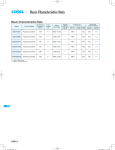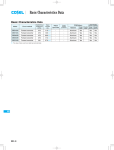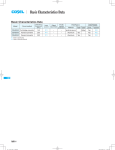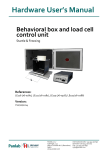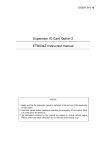Download Basic characteristics data • Instruction manual
Transcript
Basic Characteristics Data Basic Characteristics Data Model Circuit method Switching frequency [kHz] Input current [A] Rated input fuse Inrush current protection circuit Material SNDBS400B Forward converter 370 1.72 *1 450V 5A - SNDBS700B Forward converter 381 2.76 *1 450V 10A - *1 Refer to specification. *2 Refer to Instruction Manual. SNDBS SNDBS-6 Series/Parallel operation availability PCB/Pattern Single sided Double sided Series operation Parallel operation FR-4 Yes Yes Yes*2 FR-4 Yes Yes Yes*2 DC-DC Converters Bus Converter . Power Module Value-added Type Instruction Manual 1 Terminal Connection SNDBS-8 2 Connection for Standard Use SNDBS-8 3 Wiring Input / Output Terminal SNDBS-9 4 3.1 Wiring input terminal SNDBS-9 3.2 Wiring output terminal SNDBS-9 Function Overcurrent protection SNDBS-10 4.2 Overvoltage protection SNDBS-10 4.3 Thermal detection / Thermal protection SNDBS-10 4.4 Inverter operation monitor (IOG) SNDBS-10 4.5 Enable signal (ENA) SNDBS-10 4.6 Remote ON / OFF (RC2) SNDBS-11 4.7 Remote sensing SNDBS-11 4.8 Output voltage adjusting SNDBS-11 4.9 Isolation SNDBS-11 4.1 5 6 SNDBS-10 Series and Parallel operation SNDBS-12 5.1 Series operation SNDBS-12 5.2 Parallel operation / Master-slave operation SNDBS-12 5.3 N+1 Redundancy operation SNDBS-12 Implementation-Mounting Method SNDBS-13 6.1 Mounting method SNDBS-13 6.2 Derating SNDBS-13 SNDBS-7 SNDBS DC-DC Converters Bus Converter . Power Module Value-added Type 1 Terminal Connection Table 1.7 Terminal connection and functions of CN8 Pin No. 1 CN7 CN8 CN6 CN5 CN4 CN3 CN2 1 3 1 3 4 1 4 1 1 5 1 5 1 3 2 1 Function Set short-piece to 1 and 2 when ENA is Setting of ENA Enable (at shipping from factory) Set short-piece to 2 and 3 when ENA effective is Disable TB1 4 4 3 2 1 CN1 Instruction Manual Short-piece for setting is attached on CN8 at shipping from factory Table 1.8 Mating connectors and terminals of CN1,CN2,CN3,CN4,CN5 and CN6 Mating Connector Table 1.1 Terminal connection and functions Terminal connection +VOUT -VOUT No 12 34 CN1 CN2 B3P4-VH-B VHR-4N CN3 B4B-XH-AM XHP-4 CN4 B3B-XH-AM XHP-3 CN5 CN6 B5B-XH-AM XHP-5 Mfr. Reel :SVH-21T-P1.1 Loose:BVH-21T-P1.1 Reel :SXH-001T-P0.6 Loose:BXH-001T-P0.6 J.S.T. Reel :SXH-001T-P0.6 Function +DC output -DC output Terminal connector Loose:BXH-001T-P0.6 Reel :SXH-001T-P0.6 Loose:BXH-001T-P0.6 Table 1.2 Configuration and functions of CN1 and CN2 Pin No. 1 2 3 4 ENA-B -VIN NC +VIN Function : Enable signal : -DC input : No connection : +DC input Housing for protection is attached on CN2 at shipping from factory 2 Connection for Standard Use ¡In order to use the power supply, it is necessary Fig.2.1. Table 1.3 Configuration and functions of CN3 Pin No. 1 +M 2 3 +S -S -M 4 DC power supply +V Function : +Self sensing terminal. (Do not wire for external connection.) : +Remote sensing : -Remote sensing : -Self sensing terminal. (Do not wire for external connection.) SNDBS -V +V +V -V -V DC OUT ENA FG *Set short-piece to 2 and 3 on CN8 Short-pieces for without remote sensing is attached on CN3 at shipping from factory (a) Connection for DC input Table 1.4 Terminal connection and functions CN4 Pin No. 1 2 3 SNDBS Function RC2 : Remote ON/OFF TEMP : Thermal detection / Thermal protection IOG : Inverter operation monitor Table 1.5 Terminal connection and functions of CN5 and CN6 Pin No. 1 2 3 4 5 +S -S TRM VB CB Function : +Remote sensing : -Remote sensing : Adjustment of output voltage : Voltage balance : Current balance SNDPF1000 AC IN FG SNDBS AC(L) +V +V +V AC(N) -V -V -V FG ENA ENA FG *Set short-piece to 1 and 2 on CN7 for using with SNDPF1000 *Set short-piece to 2 and 3 on CN7 for using with SNDPG750 *Refer to 4.5 Enable (ENA) (b) Connection for AC input Common signs among CN4 and CN5 represent the same potential. Fig.2.1 Connection for Standard Use Table 1.6 Terminal connection and functions of CN7 Pin No. 1 2 Function S e t t i n g o f Set short-piece to 1 and 2 with SNDPF1000 Set short-piece to 2 and 3 with SNDPG750 ENA Short-piece for setting is attached on CN7 at shipping from factory SNDBS-8 DC OUT ¡ The SNDBS Series handles only the DC input. Avoid applying AC input directly. It will damage the power supply. DC-DC Converters Bus Converter . Power Module Value-added Type Instruction Manual ¡ Between the same terminal name, CN2 CN1 are power supply are connected internally. Be used in multiple units can be cascaded. Input voltage range Input current [A] Keep drawing current per pin below 7A for CN1/CN2. ¡ Operate with the conduction cooling(e.g. heat radiation from the aluminum base plate to the attached heat sink). Reference: 6.2 ”Derating” ¡ Please contact us If you need except SNDPG750/SNDPF1000 for the input . Ip Input voltage [V] 3 Wiring Input / Output Terminal Fig.3.2 Input current characteristics DC 3.1 Wiring input terminal SNDBS Load SNDBS Load SNDBS Load AC (1) External capacitor on the Input side ¡ When it turns on an input with a switch directly, one several times the surge voltage of input voltage occurs by the inductance ingre- AC Rectifier dient of an input line, and there is a possibility that a power supply may break down. Please install a capacitor between +VIN and -VIN input terminals Fig.3.3 Use wit AC input and absorb surge. Capacitor : 47μF or more (a) ¡ When the line impedance is high or the input voltage rise quickly at start-up (less than 10μs), install a capacitor between +VIN and (b) SNDBS SNDBS +VIN +VIN Di Di -VIN input terminals. ¡ Install a correspondence filter, if a noise standard meeting is required or if the surge voltage may be applied to the unit. -VIN Please contact us in details. -VIN Fig.3.4 Reverse input voltage protection (2) Input voltage rang/Input current range ¡ The specification of input ripple voltage is 40Vp-p. 3.2 Wiring output terminal ¡ Make sure that the voltage fluctuation, including the ripple voltage, will not exceed the input voltage range. ¡ Use a front end unit with enough power, considering the start-up current Ip of this unit. ¡ The specified ripple and ripple noise are measured by the method introduced in Fig.3.5. 100mm (3) Operation with AC input SNDBS ¡ The SNDBS series handles only for the DC input. A front end unit(AC/DC unit) is required when the SNDBS series +VIN +VOUT +M is operated with AC input. (4) Reverse input voltage protection ¡ Avoid the reverse polarity input voltage. It will break the power supply. It is possible to protect the unit from the reverse input voltage by Ripple Time Fig.3.1 Ripple of input voltage ψ t Input voltage range Input voltage installing an external diode. Measuring bord SNDBS +S DC Input 0.1µF Load -S -M -VIN Oscilloscope BW : 100MHz -VOUT R 1.5m 50W Coaxial Cable C R=50W C=0.01µF Fig.5.1 Method of Measuring Output Ripple and Ripple Noise SNDBS-9 DC-DC Converters Bus Converter . Power Module Value-added Type Instruction Manual 4.4 Inverter operation monitor (IOG) 4 Function ¡ By using the inverter operation monitor(IOG), malfunction of the inverter can be monitored. When inverter operation is in following mode or , IOG signal turns 4.1 Overcurrent protection H” from L” within 1 second. ¡Overcurrent protection is built-in and comes into effect at over 105% of the rated current. Overcurrent protection prevents the unit from short circuit and overcurrent condition. The unit automatically recovers when the fault condition is cleared. ¡ When the output voltage drops at overcurrent, the average output current is reduced by intermittent operation of power supply IOG circuit is designed as shown in Fig.4.1 and specification is shown in Table 4.1. 1Malfunction of inverter. 2The output voltage drops by 60% or less of the rated voltage. 3When output wattage is decreased radically to less than 10% of rated wattage. 4.5 Enable signal (ENA) 4.2 Overvoltage protection ¡ The overvoltage protection circuit is built-in. The DC input should be shut down if overvoltage protection is in operation. The minimum interval of DC recycling for recovery is for 2 to 3 minutes(*). *The recovery time varies depending on input voltage and input capacity. ¡ When I connect SNDPF or SNDPG to input of SNDBS, you can operate it to start, a stop of SNDPF by connecting ENA. In this case, please set the short-piece of CN8 on 1 pin and 2 pins to prevent the trouble of the power supply. ¡ When the power supplies are shipped from a factory, they come with a dedicated short-piece being mounted on CN7. If you use SNDPF1000 , you can use the power supplies as they Remarks: are. Please note that devices inside the power supply might fail when If you use SNDPG750 , you must set short-piece to pin2 and 3 on voltage more than rated output voltage is applied to output termi- CN7. nal of the power supply. This could happen when the customer Short-piece Short-piece tests the overvoltage performance of the unit. CN7 CN7 4.3 Thermal detection / Thermal protection ¡ Thermal detection (TMP) and protection circuit are built-in. ¡ When overheat is detected, thermal detection signal (TMP) turns 1 2 3 1 2 3 ”L” from ”H”. TMP circuit is designed as shown in Fig.4.1, and specification is shown as in Table 4.1. ¡ When overheating continues after detecting the TMP signal, the output will be shut down by the thermal protection circuit. ENA terminal Enable (at shipping from factory) ENA terminal Disable Fig.4.2 Setting of ENA When this function comes into effect, input voltage should be shut off, and eliminate all possible causes of overheat condition and lower the temperature of the unit to the normal level. ¡ If you do not use ENA , remove the short-piece to pin 2 and 3 at CN8 shown in Fig.4.3. Short-piece Short-piece 22kW SNDBS TMP or IOG 6V typ CN8 CN8 -S 1 Fig.4.1 TMP, IOG circuit Table 4.1 Specification of TMP, IOG No. Item 1 Function 2 3 4 5 6 Base pin Level voltage “L “ Level voltage “H” Maximum sink current Maximum applicable voltage SNDBS-10 TMP Normal operation “H” IOG Normal operation “L” Overheat detection “L” Malfunction of inverter “H” -S 0.5Vmax at 5mA 5V typ 10mA max 35V max 2 3 1 The ENA terminal is effective (Initial setting) 2 3 The ENA terminal is invalid Fig.4.3 Setting of ENA DC-DC Converters Bus Converter . Power Module Value-added Type Instruction Manual ¡ When the remote sensing function is used, the output voltage of the power supply may show an oscillating waveform or the output 4.6 Remote ON / OFF (RC2) ¡ You can operate the remote ON/OFF function by sending signals to CN4. voltage may dramatically fluctuate because of an impedance of wiring and load conditions. Please see Table 4.2 for specifications. ¡ Remote ON/OFF circuits (RC2 ) is not isolated from output. 4.8 Output voltage adjusting (1) Adjusting method by installed potentiometer 2.35KW ¡ Output voltage is adjustable by the internal potentiometer or by applied voltage externally. The adjustable range is 90 - 110% of the rated output voltage. 12V typ RC2 To increase an output voltage, turn a built-in potentiometer clock- l1 -S OFF wise. POWER ON To decrease the output voltage, turn it counterclockwise ¡ The output adjustment range for DBS700B is shown in Fig.4.4. 110 Output voltage [%] Fig.4.3 Remote ON/OFF (RC2) Table 4.2 Specification of output side remote ON/OFF (RC2) No. 1 2 3 Item Power ON Power OFF Base pin RC2 Open (0.1mA max) Short (3mA min) -S 105 100 60 0 0 200V 250 Input voltage [V] Fig.4.4 SNDBS700B Output Voltage Adjustment Range 4.7 Remote sensing (1) When the remote sensing function is not in use (2) Adjusting method by applying external voltage ¡ If you do not use the remote sensing function, you can short out between +S and +M and between -S and -M on CN3. ¡ By applying the voltage externally at TRM, output voltage become adjustable. When the power supplies are shipped from a factory, they come Output voltage is calculated by the following equation. with a dedicated harness being mounted on CN3. If you do not use the remote sensing function, you can use the Output voltage [V]= power supplies as they are. Applied voltage externally [V] XRated output voltage [V] 1 1 [V] ¡ If the output voltage decreases to almost 0V, output ripple may become large. (2) When the remote sensing function is in use ¡ Please see Fig.4.2 if you use the remote sensing function. Wire as close as possible ¡ When the output voltage adjustment is used, note that the overvoltage protection circuit operates when the output voltage sets too high. 4.9 Isolation SNDBS +S +VOUT + Co Load -VOUT -S ¡ For a receiving inspection, such as Hi-Pot test, gradually increase(decrease) the voltage for a start(shut down). Avoid using Hi-Pot tester with the timer because it may generate voltage a few times higher than the applied voltage, at ON/OFF of a timer. Fig.4.2 Connection when the remote sensing is in use ¡ Wire carefully. When a connection of a load line becomes loose(due to such factors as loose screw), the load current flows to the sensing line and internal circuits of the power supply may be damaged. ¡ Use a sufficiently thick wire to connect between the power supply and the load and keep the line drop at 0.3V or below. ¡ Use a twisted pair wire or a shielded wire as the sensing line. ¡ Do not draw the output current from +M, -M, +S or -S. SNDBS-11 SNDBS DC-DC Converters Bus Converter . Power Module Value-added Type 5 Series and Parallel Operation Instruction Manual ¡ Connect the sensing line and the power line by one point after connecting each power supply’s sensing pins(+S, -S). In multiple operation, sensing wires should be connected between each units for the muster connection to a load. ¡ Output current should be 10% or more of the total of the rated output current in parallel operation. If less than 10%, the IOG signal might become unstable, and output voltage slightly increasing 5.1 Series operation (max5%). ¡Series operation is available by connecting the outputs of two or more power supplies, as shown below. Output current in series ¡ IOG signal might be unstable for one second when the units are turned on in parallel operation. connection should be lower than the lowest rated current in each ¡ Please be connected diode to the +VOUT side to avoid malfunctions and damage. unit. (a) Power + Supply - Sensing point Power + Supply - CN5 Load Power + Supply - CB VB TRM -S +S PS1(Master) CN5 CB VB TRM -S +S Load PS2(Slave) Power + Supply - +VOUT CN3 +M +S -S -M Co + Load -VOUT CN6 CB VB TRM -S +S (b) CB VB TRM -S +S Load CN6 +VOUT +M +S -S -M CN3 Open Open -VOUT CB VB TRM -S +S CN6 Fig.5.1 Serial operation 5.2 Parallel operation/Master-slave operation ¡ Parallel operation is available by connecting the units as shown in Fig.5.2. ¡ You can adjust the output voltage in parallel operation by adjusting a potentiometer of just one power supply. To do so, select one power supply as the master unit and turn the potentiometers of the other (slave) power supplies clockwise to the end. Once you have done this, you can adjust the output voltage by turning the potentiometer of the master unit. SNDBS ¡ You cannot parallels operate power supplies with different output voltage or electrical power. ¡ As variance of output current drew from each power supply is maximum 10%, the total output current must not exceed the value determined by the following equation. Output current in parallel operation = the rated current per unit X(number of unit)X0.9 In parallel operation, the maximum operative number of units is 5. ¡ When the number of the units in parallel operation increases, input current increases. Adequate wiring design for input circuitry such as circuit pattern, wiring and current for equipment is required. Connect the sensing line and the power line by one point after connecting each power supply’s sensing pins(+S, -S). In multiple operation, sensing wires should be connected between each units for the muster connection to a load. SNDBS-12 CN5 CB VB TRM -S +S PS3(Slave) +VOUT +M +S -S -M CN3 Open Open -VOUT Fig.5.2 Examples of parallel operation 5.3 N+1 Redundancy operation ¡ It is possible to set N+1 redundant operation for improving reliability of power supply system. Purpose of redundant operation is to ensure stable operation in the event of single power supply failure. Since extra power supply is reserved for the failure condition, so total power of redundant operation is equal to N-1. ¡ Please contact us about N+1 redundant operation in details. DC-DC Converters Bus Converter . Power Module Value-added Type Instruction Manual ¡ In the hatched area, the specification of ripple and ripple noise is different from other areas 6 ImplementationMounting Method 6.1 Mounting method ¡ When two or more power supplies are used side by side, position them with proper intervals to allow enough air ventilation. Alumi- Load factor [%] 100 num base plate temperature around each power supply should 2 1SNDBS400B 2SNDBS700B12,24,28 3SNDBS700B36,48 50 0 -20 -10 0 10 not exceed the temperature range shown in derating curve. 20 30 40 50 3 1 60 65 70 80 90 95 100 Temperature point A [C] ¡ In case of metal chassis, keep the distance between d1 for to insulate between lead of component and metal chassis, use the CN1 spacer of 4mm[0.16 inches] or more between d1. If it is less than TB1 d1, insert the insulation sheet between power supply and metal chassis. ¡ Avoid placing the DC input line wires underneath the unit, it will increase the line conducted noise. Make sure to leave an ample distance between the line pattern Point A lay out and the unit. Measuring Point Also avoid placing the DC output line wires underneath the unit because it may increase the output noise. Lay out the pattern Fig. 6.2 Derating curve (Point A) d1 away from the unit. d1 Load factor [%] 100 50 d1 0 -20 d1 -10 0 10 20 30 40 50 60 70 Temperature point B [C] CN2 d1 TB1 Fig.6.1 Mounting method CN1 SNDBS 6.2 Derating ¡ Use with the conduction cooling(e.g. heat radiation by conduction from the aluminum base plate to the attached heat sink). Point B (C51) Measuring Point Fig.6.2 shows the derating curve based on the aluminum base plate temperature. Fig. 6.3 Derating curve (Point A) ¡ Please measure the temperature on the aluminum base plate edge side (Point A). ¡ Please consider the ventilation to keep the temperature on the PCB (Point B) less than the temperature of Fig.6.3., Fig.6.5. ¡ It is necessary to note the thermal fatigue life by power cycle. Please reduce the temperature fluctuation range as much as possible when the up and down of the temperature are frequently generated. Contact us for more information on cooling methods. SNDBS-13









